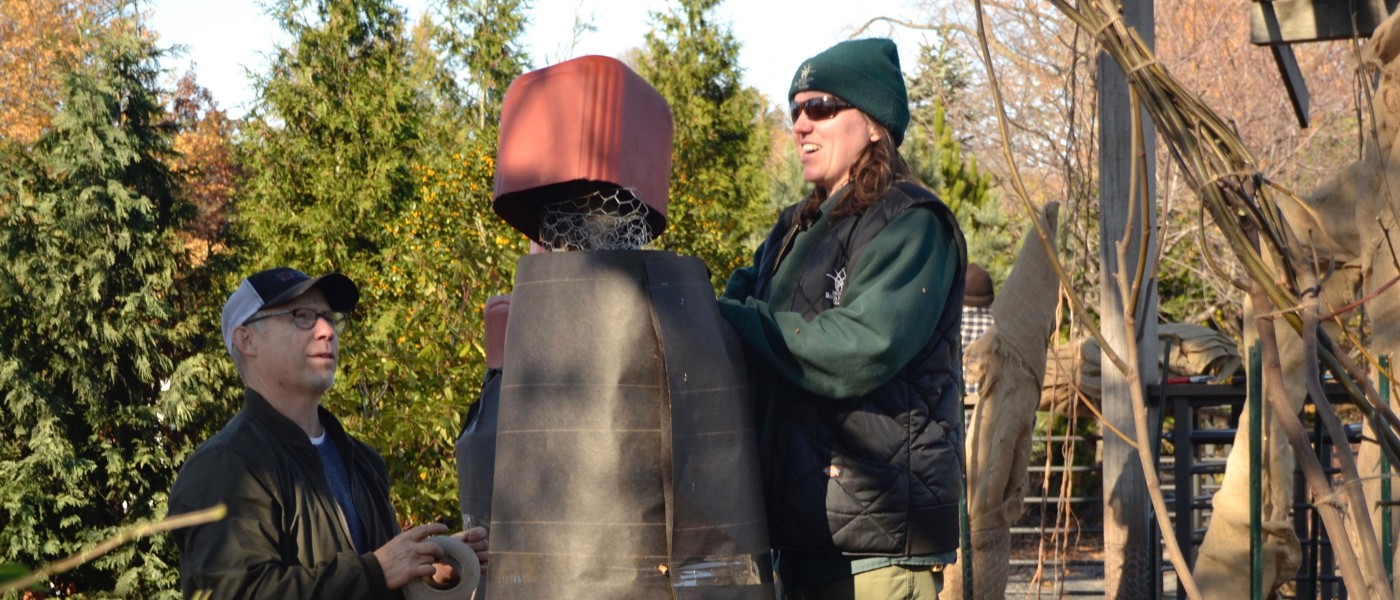How to Wrap a Fig Tree to Protect It for the Winter
The fig (Ficus carica) has long been a favorite Brooklyn garden tree, especially beloved by Italian families who immigrated to the borough in the early 20th century. Native to the Mediterranean, figs are marginally hardy here and may not survive winter in New York City unless they are protected. Although some planting tricks (such as planting your fig against a south-facing wall) can help figs survive most winters without extra care, wrapping them in layers of burlap and fallen leaves in late autumn or early winter will keep them from dying back too severely during a cold winter.
After BBG's fig trees suffered complete dieback to the ground two winters in a row a while back, we began using this technique for the specimens in the Herb Garden, with good results for the past few years. Home gardeners can follow these protective steps for backyard fig trees. Having a partner to work with will make things easier.
You will need the following:- Pruning shears
- Roll of jute twine
- Shredded leaves—about one lawn bag full for each tree. You can shred raked leaves by running over them with a lawn mower.
- A roll of burlap (roughly 60 square feet for an 8-foot tree)
- Bamboo or metal stakes long enough to frame each tree, 3 per tree
- Post-pounder tool, mallet, or hammer
- Approximately 12 feet of chicken wire for each tree
- Tar paper or roofing felt
- Stapler, duct tape, or packing tape
- Empty plastic bucket, 1 per tree
- Step stool or ladder
Step One: Prune any stems that are crossing, rubbing together, or growing horizontally. If your tree is very tall, you can remove older, taller stems to favor shorter, younger ones. Use jute twine to gather stems into an upright bundle. Wrap the stem bundle in a layer of burlap and secure it with jute twine.
Step Two: Using bamboo or metal stakes as a frame, build a chicken wire cage around each tied and wrapped tree. The frame should taper slightly toward the top.
Step Three: Wrap a layer of tar paper or roofing felt around the chicken wire frame, securing it with tape or staples. This material will repel water and still allow some air circulation. Wrap the paper with the marked lines facing outward.
Step Four: Fill the wrapped frame with shredded leaves. Note: if you have a large tree, it may be easiest to do the chicken wire, tar paper, and leaf filling in stages, working up the tree from the bottom. Layer the paper like roofing shingles to keep water out.
Step Five: When the tree is wrapped and filled with leaves, taper the sides in by cutting or folding the tar paper so that the top of the frame is narrow enough to be covered with an upside-down bucket. When you cover the frame, make sure the top layer of the tar paper is tucked within the bucket to prevent water from leaking in.
Step Six: Wrap the frame with a final (neat) layer of burlap, securing it with staples or jute twine.
Plan to remove the wrappings when the weather warms at the end of winter, after any danger of an extended frost. We usually unwrap ours in late March. Even with the unpredictable swings in temperatures we’ve been having in New York recently, this treatment will ensure that your figs stay warm and dry all winter and will lead to a bountiful harvest come next summer!
Read More: Fig Trees for Small Backyards or Container Gardens


